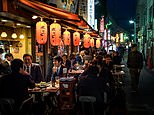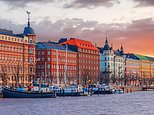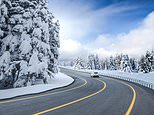
Japan is known for many things.
Its huge cities are punctuated by skyscrapers and neon lights, the streets are clean, the food is great, the countryside is famed for tranquillity and beauty.
What’s less well-known is its relationship with alcohol.
If you wander the streets of Tokyo at night, it’s common to see men in suits asleep on the street after one too many, or passed out on a carriage of the metro.
One cause is that it is customary not to refuse a drink after work, and it is considered rude not to drink at the same pace as your boss.
If your boss is having another pint, so are you. But more than a third of Japanese people are intolerant to booze and find their faces flush red whenever they drink.
Despite this, the Japanese love to drink. Indeed, the recent cyber attack-induced shortage of national favourite beer, Asahi, will no doubt have struck fear in the hearts of many.
Smoke-filled bars are full of shouting customers, The beer is ice-cold, the fruity ‘chuhai’ is strong and the drinks are usually accompanied by world-class food. In fact, fifty-five bars in Japan are in the Michelin guide.
Boozing is a key part of Japanese culture. Many will have been aghast at the shortage of Asahi, the nation’s favourite beer, following a recent cyber attack
Drinking is deeply engrained in the Japanese workplace. it is customary not to refuse a drink after work, and it is considered rude not to drink at the same pace as your boss
Navigating this wonderful world as a foreigner, however, is difficult. Most menus are in Japanese and bar staff outside of tourist locations rarely speak English.
Bars can be cramped and often ordering is done by simply shouting what you want.
But while it might be tempting to walk into a western style pub, the payoff for stepping outside your comfort zone is to experience a truly unique drinking culture.
On the other side of a few awkward moments are cheap drinks, great food, and most importantly – some new drinking buddies.
Here’s everything you need to know for tackling boozing and nightlife in the Land of the Rising Sun.
Food
Washing down pints with a packet of crisps simply won’t cut it. To drink like a local in Japan, understand that drinking and eating go hand-in-hand.
Head to an ‘izakaya’ – the Japanese word for bar that also sells food.
Izakayas serve a variety of different foodstuffs, with popular options including fried chicken, or ‘karaage’, edamame beans, tofu dishes and sashimi
They can range from tiny counters and standing bars where beers are sold for around £2.50, to fine dining where a set menu can set you back £125.
If you’re looking for the authentic drinking experience, stick to the cheaper joints.
Yakitori (literally ‘grilled chicken’) bars are also worth a visit; skewers of grilled chicken thigh or neck might be your new favourite booze food.
Much like tapas, dishes are sold in small plates and are meant for sharing. You will want to order a few dishes to get a sense of where the bar excels.
If you like meat and fish, you will have plenty of options. Staple options include karaage (Japanese fried chicken), sashimi (raw fish), or any type of grilled fish or shellfish. Grilled prawns are a go-to option for many.
For a less meaty option, try agedashi tofu (Deep-fried tofu) or grilled miso aubergine. You can pair these with a seaweed or tofu salad.
The price tag
Low levels of inflation and a weak yen have meant there has never been a cheaper time to visit Japan.
Karaage, Japanese fried chicken, is a popular accompaniment to drinking
If you like drinking and eating to your heart’s content, you’re in the right place.
A popular deal for many izakayas is the ‘sen-bero’ offer. This translates to: get drunk for 1000¥ – roughly £5.
Yes, for less than the price of a pint in many British pubs, you can have two to three drinks and a small plate of food.
But even without such offers, most izakayas are cheap when compared to similar British establishments.
A beer can cost 400¥ (£2), a whisky highball 600¥(£3), and a chicken skewer usually comes to around 250¥ (£1.20).
Smoking
Most traditional bars in Japan allow you to smoke inside.
While this may sound ideal if you love a post-beer cigarette, you may baulk at the idea of sitting inside with smokers – particularly if you’re in a compact shanty bar.
Tokyo’s business district, Shinbashi, has plenty of izakays to serve office workers looking to grab a cold beer after work
Where possible, ask for the non-smoking section, which most bars offer today, known as the kinen seki.
Where to go
Unsurprisingly, Japan’s capital Tokyo has a plethora of different watering holes to choose from – wherever you’re staying, you’ll find somewhere to grab a drink.
Here are some of the most popular neighbourhoods for hitting the town.
Shinbashi
As a business district, this area’s izakayas are there to serve the ‘salarymen’ (office workers) of the area. You may even spot a man in a suit sleeping on the street here.
Shinbashi houses the highest concentration of bars in Japan, with 1066 izakayas found in the 500 metres around the station.
Head after work to spot salarymen in the wild – you might even make a few new drunken friends.
Golden Gai, a popular network of alleyways in Tokyo’s Shinjuku district, is home to over 200 shanty-style bars
Ueno
This northern eastern spot is popular particularly with a slightly younger crowd.
Find izakayas lining the streets and thousands of bargoers sitting alfresco in the warmer months.
Shinjuku
Shinjuku has the busiest train station in the world, used by approximately 2.7 million people every day. And with lots of people to feed, there are bars aplenty.
The Golden-Gai is a set of photogenic alleyways, with over 200 tiny bars amongst its lanterns and neon lights.
Avoid the tourist traps in the nearby red-light district.
Shibuya
Unlike us Brits, Japanese people usually opt to eat alongside their boozing, and ‘izakayas’, Japan’s answer to the pub, are home to some of the country’s best food
While not as famous for its izakayas as the other locations, Ebisu Yokocho, just one stop from the main Shibuya station, is teeming with eateries and bars.
Get some unique foods here like the Tokyo-born ‘oden’ hot pots and Japanese rolled omelettes.
Ikebukuro
Another major rail station, Ikebukuro is known for Sunshine City, a shopping centre with an aquarium on the roof and all-day watering holes.
Exit the station from the west exit for the highest number of izakayas.
Osaka
Tokyo’s cheerier sibling, Osaka has a younger, and perhaps looser, drinking culture. Try Namba or Umeda to get a proper taste.
When in an Osaka izakaya, you should order a ‘kushikatsu’– a deep-fried skewer of meat or vegetables. These sticks are dipped in a special sauce. The only rule here is to avoid double-dipping the skewers into the sauce.
Source link
CHECK OUT: Top Travel Destinations
READ MORE: Travel News



